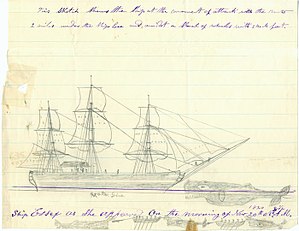Essex (1799 whaleship)
|
A whale striking Essex on 20 November 1820 (sketched by Thomas Nickerson)
|
|
| History | |
|---|---|
|
|
|
| Name: | Essex |
| Laid down: | Amesbury,Massachusetts, United States |
| Launched: | 1799 |
| Fate: | Struck by a sperm whale and sunk, 20 November 1820 |
| General characteristics | |
| Type: | Whaler |
| Tons burthen: | 238 72⁄95 (bm) |
| Length: | 87 feet 7 inches (26.7 m) |
| Beam: | 24 feet 0 inches (7.3 m) |
| Depth: | 12 feet 6 inches (3.8 m) |
| Notes: | Four whaleboats, 20–30 feet (6.1–9.1 m): plus one spare |
Essex was an American whaler from Nantucket, Massachusetts, launched in 1799. While under the command of Captain George Pollard, Jr., in 1820 a sperm whale attacked and sank her. The sinking stranded the twenty-man crew in the southern Pacific Ocean with little food and water. During the 95 days that the survivors were at sea, they ate the bodies of five crewmen who had died. When that was insufficient, members of the crew drew lots to determine whom they would sacrifice so that the others could live. A total of seven crew members were cannibalized before the eight survivors were rescued. First mate Owen Chase and cabin boy Thomas Nickerson wrote accounts of their ordeal; these accounts inspired Herman Melville to write his famous 1851 novel Moby-Dick.
Essex was an old ship, but because so many of her voyages were profitable, she gained the reputation as a "lucky" vessel. Captain George Pollard and his first mate, Owen Chase, had served together on a previous, successful trip, which led to their promotions. Only 29, Pollard was one of the youngest men ever to command a whaling ship. Owen Chase was 23, and the youngest member of the crew was the cabin boy, Thomas Nickerson, who was 14.
Essex had recently been totally refitted, but at almost 88 feet (27 m) long, and measuring about 239 tons burthen, she was small for a whaleship. Essex was equipped with four whaleboats, each about 28 ft (8.5 m) in length. In addition, she had a spare whaleboat below decks. These boats were clinker built, with planks that overlapped each other rather than fitting flush together.
Essex left Nantucket on 12 August 1819, on what at the time was expected to be a roughly two-and-a-half-year voyage to the whaling grounds off the west coast of South America.
...
Wikipedia

